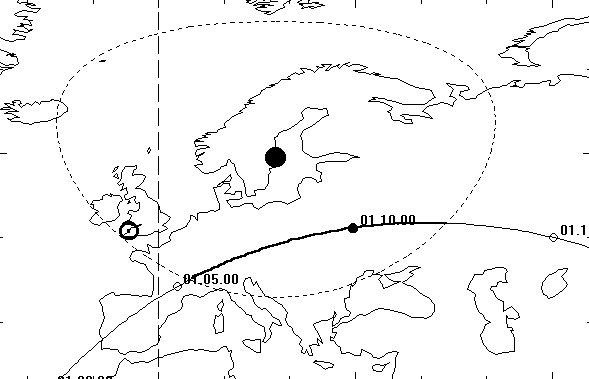
Figure 1 Salyut
3 pass early on June 28, 1974 when signals on 19.944 MHz were first detected
After the launch of Salyut 3 on June 24, 1974, the Kettering Group scrambled to the radios to try to pick up signals. But, just as was the case with Salyut 2, nothing was heard on the typical frequencies used by Soyuz and Salyut 1. We feared the worst - to be cut off from all radio communications with a major Soviet space mission. When I talked to Geoff Perry in the evening of June 27 he said: "Maybe we have been stupid. Perhaps the item in Aviation Week should be read without any prejudice. Maybe it refers to short-wave recon-satellite signals being similar to Salyut 2 telemetry". The Aviation Week article he referred to was published on September 3, 1973 and reads as follows:
"Soviet penchant for secrecy within its own space program has lead to a widespread, but erroneous, belief that a Salyut spacecraft failed while in orbit. The spacecraft, which the Soviet press and information agencies called a Salyut, was launched Apr. 3 and apparently suffered a catastrophic failure on Apr. 14. However, the spacecraft transmitted on a different frequency than previous Salyuts and now is believed to have been a different spacecraft. The reports initially issued by the Soviets apparently were incorrect because of an attempt to keep secret the actual nature of the spacecraft. Telemetry transmission from the spacecraft were similar to those monitored earlier from Soviet reconnaissance satellites."
Geoff Perry suggested we should try 19.150 MHz, 19.990 MHz and 19.994 MHz. I agreed, and set the alarm clock for 0045 UT to catch a close pass of Salyut 3. The frequency band 19-20 MHz was almost "dead" that night, i.e. no long-range propagation of signals. This meant that any signals from Salyut 3 would only be audible while over the horizon in Stockholm, and there were almost no other stations that could interfere. It ought to be easy to find the signal. I slowly tuned up from 19 MHz, and at 0107:45 UT I suddenly picked up the typical FSK-PDM signals similar to those from 12-day Cosmoses and Proton satellites and Cosmos 110. The signal grew in strength and finally faded out at 0112:50 UT. I measured the frequency with the WW II BC-221 frequency meter to be 19.946 MHz. (later determined to be 19.944 MHz) Both the frequency and signal format was different from Salyut 1.

Figure 1 Salyut
3 pass early on June 28, 1974 when signals on 19.944 MHz were first detected
Salyut 1 was on 15.008 MHz and 20.008 MHz and used CW-PDM, i.e. a carrier that was keyed on and off where the length of the ON periods represent telemetry values. Even though this discrepancy was obvious and the mysterious Cosmos 557, which everyone thought was a failed Salyut used 15.008 MHz and 20.008 MHz like Salyut 1, we still hesitated to divide the Salyut series into two distinct groups or categories.